Alberto Ruz Buenfil is the kind of spirited soul that shakes society.
His father was a notable archaeologist that unearthed the tomb of Pakal in the ancient Mayan city of Palenque, in the Yucatan region of Mexico, where he grew up. In 1968, at the tender age of 22, Alberto left Mexico and embarked on a long journey. Influenced by the global counterculture movement, he travelled with a group of friends across North America, Europe, North Africa, the Middle East and India. In each town they’d stay in an eco-village or community and learn from their alternative ways of living. With old beaten cars, they would drive in “caravan”, and upon arrival they would put on a theatrical show as an offering for the welcome of that community.
“We ended up travelling as a group for eight years. In those years, our nomadic tribe went everywhere: from communities in Sweden to ashrams in India and eco-villages in Greece. As the years went by members of the tribe began having children and so we decided it was time to stop. The kids were asking for more permanent friends and the women wanted a place to build a nest, so we went back home to Mexico.”
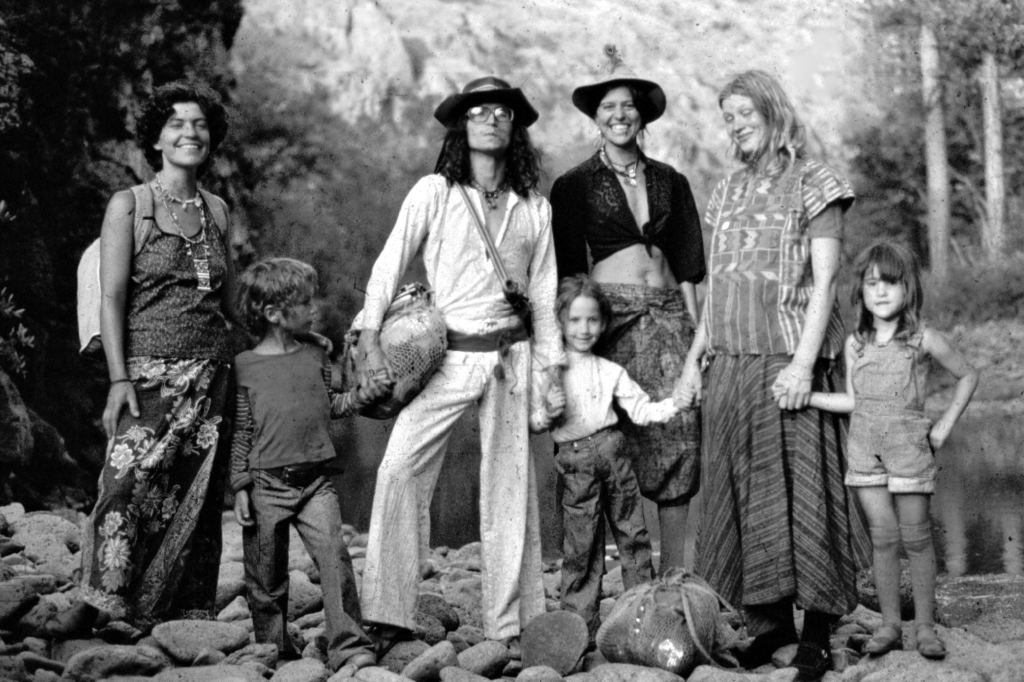
This tribe, now composed of 20 adults and 12 children, searched the country for the ideal settlement to start their own community. They travelled the country until Alberto stumbled upon Tepoztlan, a charming town just one hour south of Mexico City.
“This place called us, he searched for us, he found us. I was the one who arrived first and what most attracted me was a tree, a fantastic tree. After seeing that tree, I saw the possibility. Even though it didn’t have wells or springs, and it was a very dry spot, we had learned in our travels how to deal with arid landscapes from our time in a Kibbutz in Israel. If they could grow anything in the desert, then we could live here too. So we settled here in 1982 and named it Huehuecoyotl.”
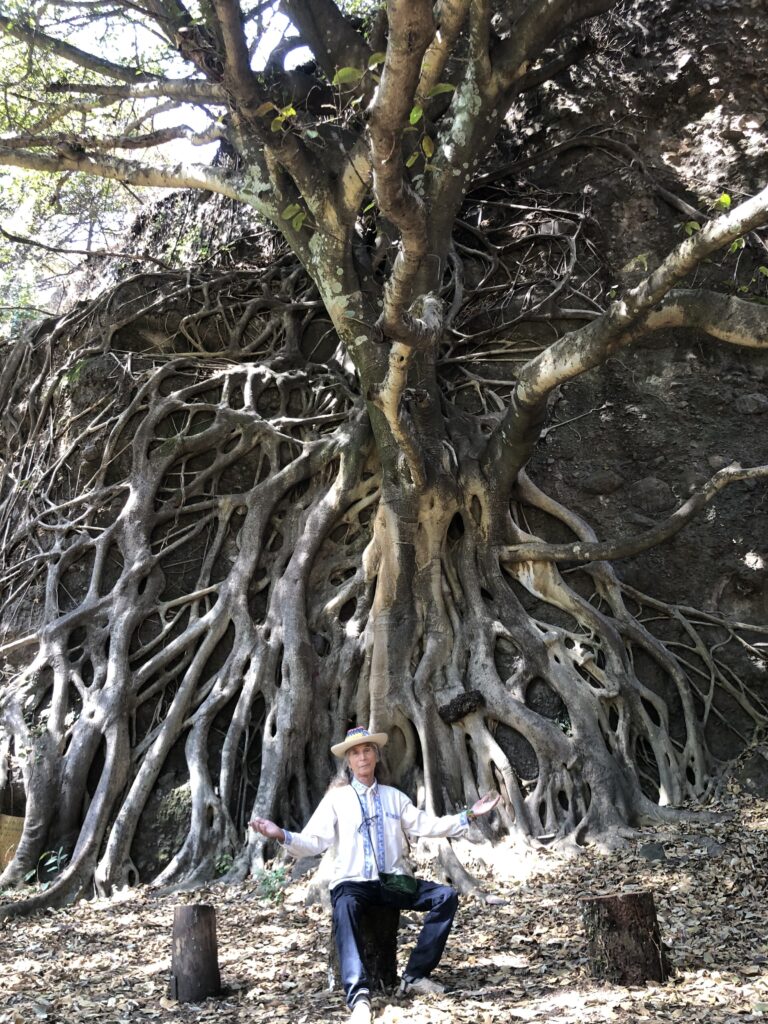
Huehuecoyotl is the god of the arts, music and ceremonial dance in the Mexica tradition.
“Each community tends to have a common interest that brings them together, from our years traveling the World we knew that ours was our passion for the arts.”
Huehuecoyotl also means “old coyote” in Nahuatl, which is also how eventually Alberto received his nickname, El Coyote.
“The first thing was to open up a path, then we built a water catchment to be able to sustain ourselves. When our children grew up we built a school. Of course we were the teachers. Then parents from the town began sending their kids to our school, because we offered an alternative system. This also allowed our children to meet kids from outside of the community.
“As a community we developed what we call ‘eco-techniques’ and began hosting workshops and teaching them here. As my father was an archaeologist, I knew the importance of preserving history, so throughout the years of travel I had kept testimonies of everything that we had lived, which became the content of our conferences, shows and books. We even had a monthly magazine.”
The magazine focused on stories of community, land rights, and eco-techniques to live in harmony with nature, avant-garde content for Mexico in the 1980s.
By 1996, at the age of 50, El Coyote felt the call of the road again and embarked on another epic journey, this time he headed south.
“I was always inspired by movement. Movement opens the head, opens the heart, opens your vision of the world, opens everything it has to offer. And I have always been like that. All my life I’ve tried to learn more and more and more from everywhere I go and from the people that I meet. So in 1996, I left with a bus from here and headed to Tierra del Fuego, to the end of America. I started a new caravan. We left here in June of 1996 and had enough money for gasoline to get to Puebla.”
Puebla is a city two hours drive south from Huehuecoyotl. The bus had already journeyed from Colorado, a classic American school-bus, a gift from a close friend. After converting it into a mobile home, El Coyote set-off, accompanied by a new group of young adventurers.
“About ten other people got on the bus, and at the last moment a lady with a van joined too. That’s how “the Caravana Arcoiris por la Paz” (the Rainbow Caravan of Peace) was formed. So once we arrived in Puebla, we thought how are we going to get to Veracruz? Well, we are going to host workshops and give presentations on eco-techniques, because that’s what we know how to do. In my opinion when you arrive somewhere you have to offer something. Not see what you can get, but what you can give. So that’s what we did. I have friends in Puebla who received us and helped us organise the workshops. Then from there we went to Veracruz and did the same. In Veracruz, the Zapatistas heard about us and invited us to go to Chiapas. So we headed down to Chiapas.”
The Zapatista Army of National Liberation is a far-left political militant group that has been at war with the Mexican state since 1994. The group takes its name from Emiliano Zapata, the commander of the Liberation Army of the South during the Mexican Revolution. They aim to continue Zapata’s work of land reforms and Indigenous Rights, to this day they control large areas of the region of Chiapas.
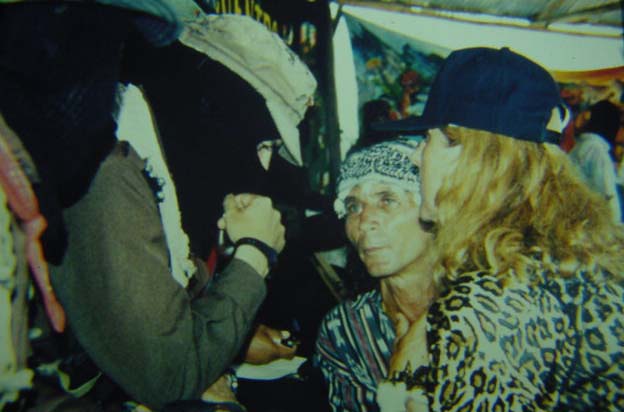
“At that time, the Zapatista movement was hosting a meeting of thousands of people, about 6000 left radicals from all over the world. The Zapatistas built a tent city for them, with bathrooms and dining rooms and all. So we got there with our bus and the other little truck, and brought some gifts, among them my books and our music, and we gave it to Subcomandante Marcos, we then interviewed him too. Then we settled in the Zapatista community and did the same thing: first bring out the theatre and then give workshops about eco-techniques. We stayed there for about a month. The event had ended and everyone left, but we stayed there, living, coexisting with the Zapatista community and learning a lot from them too.”
Initially, El Coyote thought the journey south would take him two to three years, instead it lasted thirteen. From war zones to crowded favelas and remote Indigenous villages, everywhere they went the Rainbow Caravan for Peace would first put on a theatre show and then host workshops teaching eco-techniques to the locals, just how they had done for the Zapatistas. Their workshops taught locals different things: from how to build solar panels and rain catchment technologies, to composting and alternative eco-schools. In many towns and cities they would also convene gatherings of local environmental and Indigenous groups, so they could share their knowledge too.
“We also organised and convened two huge international gatherings, one in Peru, at the foot of Machu Picchu and the other in Brazil, in Alto Paraíso. We hosted other smaller gatherings in communities across Chile, Colombia, Ecuador, in each place we travelled to. The gatherings attracted environmental groups, Indigenous groups, artists and everything in between. They would usually last a week and they were the impetus for what then became the Council of Visions of Guardians of the Earth and CASA: the Council of Sustainable Settlements of Latin America.
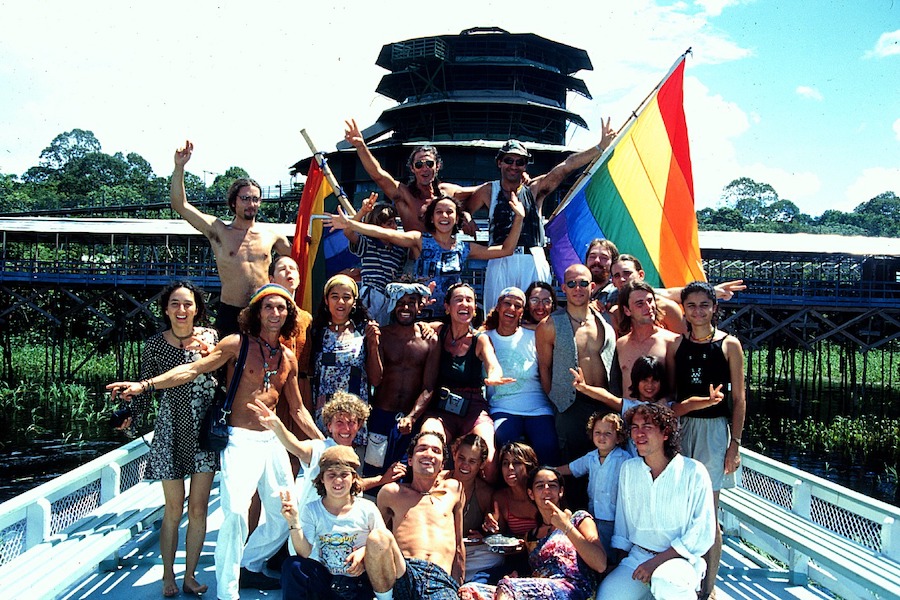
“In some countries we stayed for months, in other countries we stayed for over a year. That is why it took us so long. Although we were travelling at an interesting historical moment, where neoliberal governments were being replaced by social, leftist governments. So borders that before would’ve been closed to us, all welcomed us instead. Doors were opening everywhere for us to continue working with communities, hosting workshops, conferences, gatherings, shows. So yes, we left a mark, a very beautiful mark everywhere we went. And on those trips, we began to form relationships with the locals, people left the caravan, new ones joined, couples were formed and new projects were mushrooming everywhere we had been.”
In 2005, the Rainbow Caravan of Peace made it to Tierra del Fuego, Argentina, nine years after leaving Tepoztlan.
“Once we arrived in Tierra del Fuego, we had the invitation to hold another great gathering in Brazil, ‘The Second Great Call of the Beijaflor (Hummingbird)’ in Alto Paraíso. Well technically the trip was done, we had reached Tierra del Fuego, which had been my commitment to the Great Spirit, to reach Tierra del Fuego and raise the rainbow flag, the flag of the land and the flag of peace among the glaciers. I had lowered the Argentinian flag and put up ours instead, but nevertheless we headed back north to help setup this large gathering.”

At the Second Hummingbird Gathering in Alto Paraíso, El Coyote met Gilberto Gil, then the Minister of Culture of Brazil. Gil knew about El Coyote, he had read his latest book on his caravan travels and was inspired by all of the work he had accomplished across the continent. Gil is one of Brazil’s most notable figures, a famous musician from Bahia and a vocal opponent of Brazil’s previous military government.
“So Gil told me ‘I want you to join us here in Brazil, to become part of the project we are doing now. The money that is allocated to culture, for the whole country, always goes to the same things: opera, art, dance, carnival. But now we are going to allocate it to living culture points. And I need a caravan that goes to different towns across the country and brings the communities together and celebrates their local traditions and knowledge. And you already have the caravan and the know-how. You already did it in 16 other countries, you have the experience. Please, do it here.’”
The Rainbow Caravan for Peace spent four more years travelling around Brazil. This would be the first funding the caravan and its tribe received.
“The only time when we had institutional money was when we were working with the Ministry of Culture of Brazil, with Gilberto Gil. There he gave us money to repair the vehicles, to buy a truck, to have better equipment, and for the first time each of the members of the caravan received what was equivalent to 100 reais a month. The rest of the time, there were no wages, there were no privileges. I was never privileged, I worked in mechanics, in the dry latrines, in everything that had to be done. The caravan years took me from 50 to 64 years. Then I remembered the Beatles song ‘When I’m Sixty-Four’, and I decided that it was time to head home.”
In 2009, the World Social Forum Gathering was taking place in Belem de Para, where the Amazon River meets the Atlantic Ocean. The event attracted 150,000 people and discussions ranged from the protection of the Amazon Rainforest to alternative economic models. El Coyote decided it would be the ideal setting to end the Rainbow Caravan of Peace’s epic voyage.
“When we got to the forum we built a circus tent for 500 people. Sound, lights, costumes, cooking, everything. By then we knew how to set this stuff up, we called it ‘The Village of Peace’ and hosted talks and shows. After it ended, I told the tribe ‘this is where my journey ends, I’ll stop here. Whoever wants to continue, can continue.’ And I gave away one of the buses, and the other one I sent to Mexico thanks to donations. The one that is parked here.”
In the 13 years of travel, 450 people joined and left the Rainbow Caravan of Peace from a total of 17 different countries. El Coyote was the only one that travelled the entire time.
“I have done all this as a service to Mother Earth, as a volunteer for humanity. On that trip it became very clear to me, especially after having lived for a long time in the towns around the Andes with the Aymara peoples, that Pachamama comes before anything else. We ecologists knew it, we knew that the Earth was not ours, but that we belong to the Earth, but it is one thing to know it and another to live it.
“The Aymara, they live it. Their concept of Sumak Kawsay (good living) is still alive, which means caring for Mother Earth. So having learned that lesson, at a certain point I realised we cannot exclude the legal part of the rights of Mother Earth, it can’t just be a ceremony, it has to become law. And then I read that Evo Morales, who was the President of Bolivia at the time, had brought the first Declaration of the Rights of Mother Earth to the United Nations, and I said to myself ‘wow, well that’s what I want to do from here on out.’ So in 2009, I closed the chapter of the caravan in Belén de Para.”
Back in Mexico, El Coyote returned to Huehuecoyotl. He was then hired by the local municipality of Coyoacán to implement his workshops at the neighbourhood level, he called these “eco-barrios” (eco-neighbourhoods) and he spent three more years holding the same eco-technique workshops around the southern part of Mexico City, with the same bus that had criss-crossed the Americas.
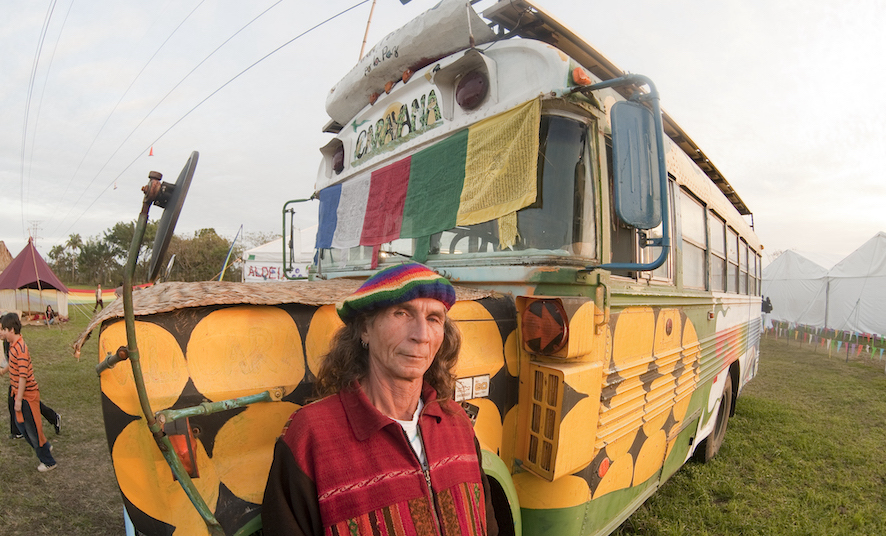
“We created a small group of ten people and travelled to ten neighbourhoods of Coyoacán. We mainly held a training program of 40 to 50 eco-techniques, from how to build an ecological house to how to teach at an ecological school. The idea was to give the local leaders of the communities the tools so that then they could develop their own projects.”
Many of the neighbourhoods they entered were dangerous, controlled by gangs and narcos. Yet, El Coyote and his team would arrive and the first thing they would do was put on their signature theatre show, this would make them stars with the neighbourhood children and therefore grant them protection from the local gang leader. El Coyote reminisces that despite the areas of high risk that he worked in, nobody from his team was ever hurt. At the end of the training courses they would bring the students back to Huehuecoyotl for a weekend.
“We brought them here to camp and for three days we showed them how to build what they had learned in the workshops. For example how to make a solar panel, or how to make a rain catchment system, build compost toilets, etcetera. Many of the attendees had never lived a week without witnessing a shootout. We would host singing circles around a fire and cook-outs outside. Everyone always left inspired.”
After his neighbourhood work, El Coyote was engaged by the Governor of Morelos to become the State’s Director of Environmental Culture.
“So I started doing things like I’ve always done. I still had the truck, we still had the samples, we still had a number of things, and I started trying to do them in the state. And it didn’t work. I began to see that there was a blockade on the part of the Secretary of Sustainable Development, who did not want me to do anything but sit there from eight to five every day. So I knew I wouldn’t stay long, but during that time I did manage to install an ecological house in Cuernavaca’s main park. A beautiful ecological house with ten eco-technologies: ten solar panels, bicycle pumps, a rain catchment system, an orchard, everything. Next to it we set up a large cultural centre and began hosting events that celebrated Earth Day, Water Day, the day against open-pit mining. Such were the things that we celebrated, instead of ‘Saint Day’ or ‘Independence Day’ or ‘Revolution Day’. Everything we celebrated was related to ecology. That didn’t go well with the Governor.”
After his stint in Mexican institutions, in 2015 El Coyote returned to his home of Huehuecoyotl and shifted his attention to the realisation he had had at the end of his voyage, to focus on spreading the Andean vision of giving legal rights to nature.
“In the summers I would go to Italy and friends would organise a tour for me all over the country in several different towns. I would usually stay two to three days in each place. One summer I visited 25 towns. In each I gave talks, hosted gatherings, opened temazcales and at the end of each visit I delivered ‘The Universal Declaration of the Rights of Mother Earth’ to the Mayor, as well as a flag of peace to put in their municipality. I did the same in Switzerland and Spain too.”
Since the pandemic El Coyote has been promoting the legal rights of Mother Nature online instead, while also publishing memoirs of his adventurous life.
“I decided from a very young age not to live a normal life and not to live only one life. So all those who speak of their past lives and how their souls had reincarnated from Napoleon or Cleopatra etcetera. Well I decided not to investigate my past lives, but instead live many lives in one.”
Alberto Ruz Buenfil lives his life in service to Mother Nature. Many projects and organisations emerged thanks to the Rainbow Caravan of Peace’s work across the Americas. The eco-techniques developed in Huehuecoyotl are now being taught at universities in Mexico; his legendary gatherings still bring hundreds of environmentalists together every year; and Coyoacán is the neighbourhood in Mexico City with the most urban food farms, thanks to his eco-barrios initiative. El Coyote’s achievements are a testament of how environmental change emerges through strengthening communities with creativity and consciousness.
“I always quote the same phrase from Martin Luther King: ‘even if I knew that tomorrow the world would go to pieces, I would still plant my apple tree.’”
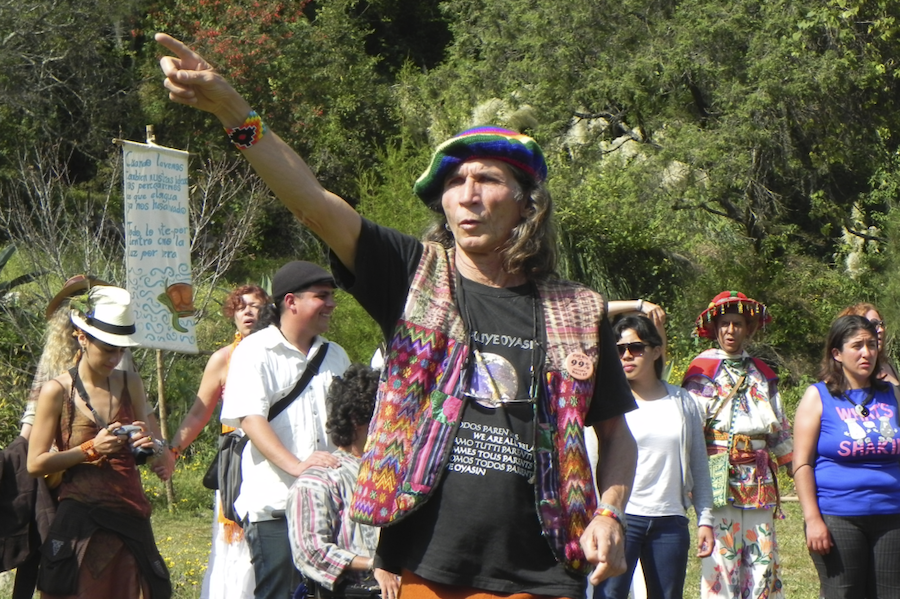
You might also like: International Mother Earth Day
Isabella Cavalletti is a storyteller and co-founded eco-nnect.













